The iPhone 12 & 12 Pro Review: New Design and Diminishing Returns
by Andrei Frumusanu on November 30, 2020 8:30 AM EST- Posted in
- Mobile
- Apple
- Smartphones
- Apple A14
- iPhone 12
- iPhone 12 Pro
Display Measurement
The new iPhone 12 and iPhone 12 Pro have on paper almost the same display characteristics, both being 6.06” OLED panels with 2532 x 1170 resolution, however they differ in their characteristics when looking at the peak maximum brightness achieved, with the regular iPhone 12 model peaking at 625 nits and the 12 Pro peaking at 800 nits.
We’re not exactly sure as to the actual manufacturing differences between the two panels, but one thing that I immediately noticed as being different between the two models is their viewing angles. The iPhone 12 showcased a larger off-axis brightness drop-off and what I would consider a more classical OLED off-axis colour tint, while the iPhone 12 Pro behaved significantly better with almost perfect off-axis brightness and colour performance. This points out to a quite different lamination process and maybe different polarisation layer between the two models.
We move on to the display calibration and fundamental display measurements of the iPhone 12 screens. As always, we thank X-Rite and SpecraCal, as our measurements are performed with an X-Rite i1Pro 2 spectrophotometer, with the exception of black levels which are measured with an i1Display Pro colorimeter. Data is collected and examined using Portrait Display's CalMAN software.

In terms of display brightness, we pretty much measure figures in line with Apple’s advertised marketing and specifications, with the new iPhone 12 reaching 631cd/m² and the iPhone 12 Pro reaching a significantly higher 839cd/m². The latter figure is the highest and brightest amongst any OLED device we’ve ever measured, although it’s not all that much brighter than the iPhone 11 Pro models.
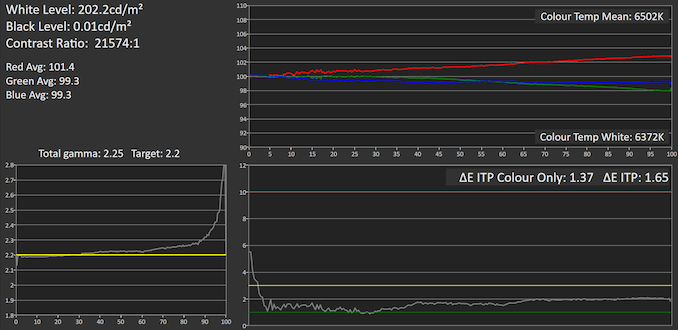
 Portrait Displays CalMAN
Portrait Displays CalMAN
iPhone 12 Pro
We start off the detailed measurements with the greyscale performance of the iPhone 12 Pro. Generally speaking, there’s very little to criticise the device here as there’s generally an excellent performance. Apple still showcases higher gamma at higher level colours, but that’s only a minor imperfection.
The white balance for whites actually is a tad warmer than it should be with some clearly higher-than-average levels of red. Although the total average white balance over all levels lands in at an excellent 6502K, actual whites land in at 6372K. It’s not an issue, but a little less perfect than we had come to expect from iPhones.
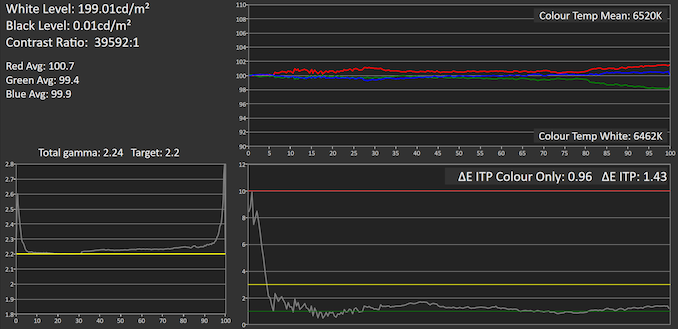
 Portrait Displays CalMAN
Portrait Displays CalMAN
iPhone 12
The iPhone 12 seems to showcase a different calibration than the 12 Pro, further evidence of the two different panels employed on the two models. The 12 seems to have slightly better gamma behaviour on the higher levels, but in exchange showcases worse off gamma at the lower levels, clipping lower level colours to black earlier than on the 12 Pro, which had near perfect behaviour here.
Oddly enough, colour temperature on the 12 behaved better than our 12 Pro sample. Average colour temperature landed in at 6520K while white landed in at 6462K, with less dominant reds than on the other phone.
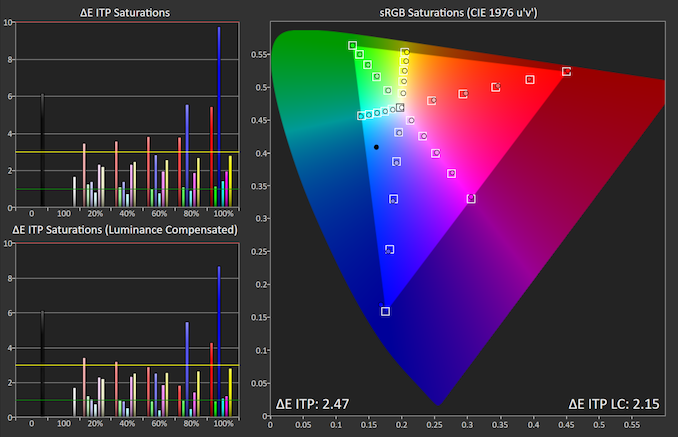 Portrait Displays CalMAN
Portrait Displays CalMAN
iPhone 12 Pro
sRGB colour saturations on the iPhone 12 Pro are quite excellent, with the biggest error margin happening at maximum saturation blues and magentas, with also a slightly oversaturated red. Below maximum intensity, the colours are all showcasing dEITP errors below 3 which is the just perceivable threshold for the average eye.
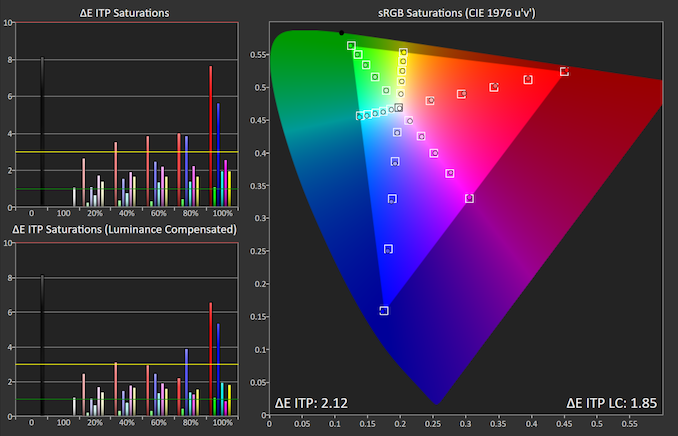 Portrait Displays CalMAN
Portrait Displays CalMAN
iPhone 12
The iPhone 12 has slightly better results, with the blue and magenta error being less pronounced on this phone. Generally it looks that our sample here is again performing a little better than our 12 Pro sample.

 Portrait Displays CalMAN
Portrait Displays CalMAN
iPhone 12 Pro
In our GMB chart with common colours such as skin tones, the iPhone 12 Pro behaves admirably. Given the phone’s inaccuracies seemed to be more prevalent in higher saturations in the blue and red spectrum, and this test doesn’t contain patches in that region of the gamut, it means that the remaining test colours perform extremely well.
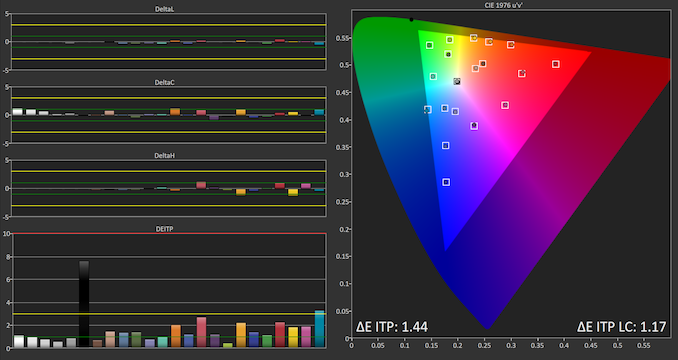
 Portrait Displays CalMAN
Portrait Displays CalMAN
iPhone 12
The iPhone 12 generally seems to beat the iPhone 12 Pro in terms of accuracy, again showcasing better results and an outstandingly good overall error result of dEITP of 1.44.
Apple Typical Best Displays
Overall, the new iPhone 12 series continues Apple’s tradition of having amongst the best calibrated displays on the market. The 12 Pro seems to just shy away from the usual Apple perfection, but the results are still outstandingly good and beyond that of any other device.
I think what’s most important for this generation of devices is the fact that the iPhone 12 now features a higher resolution OLED screen. It can’t be understated how much of an upgrade this is compared to the “Retina” grade LCD panel of the iPhone 11. Personally, this makes the iPhone 12 an actual consideration whereas I wouldn’t have been satisfied with using the iPhone 11’s LCD. It also vastly diminishes the feature gap to the Pro models – I don’t consider the brightness advantage of the 12 Pro to be all that significant, although again the Pro model does showcase better viewing angles and a more pronounced “sticker feel”.










101 Comments
View All Comments
vFunct - Tuesday, December 1, 2020 - link
"Portrait-mode" is the least important piece of information necessary here for a camera review.You test your subjects on people to understand how well it recreates skin tones and textures.
There were issues with previous iPhones where it would over-smooth skin textures leading to a plastic doll-like effect, for example.
michael2k - Tuesday, December 1, 2020 - link
Right, but that requires you perform a Portrait Mode test, which you just claimed was the least important piece of information here.You cannot perform a test of the camera's skill at rendering skin tone and texture without also executing the Portrait Mode code, since that is the code that was creating the over-smooth skin texture.
PickUrPoison - Saturday, December 12, 2020 - link
That over smoothing was corrected after a few weeks with an update.ABR - Monday, November 30, 2020 - link
The larger phones are real porkers. I have no desire to carry a half-pound of phone around, and that's before a case!name99 - Monday, November 30, 2020 - link
My favorite color is blue.Maybe everyone wants to chime in with totally non-technical personal statements of choice?
The Garden Variety - Monday, November 30, 2020 - link
When I'm taking photos of my pizza with my iPhone, I tend to prefer almost any kind of pizza. Meat pizzas, veggie pizzas, thin crust, thick crust, New York-style crust, whatever. Not picky about pizza. Don't really care for Chicago-style, as it's basically just dough and cheese, but other than that, I'm pretty easy to please.flyingpants265 - Tuesday, December 1, 2020 - link
Wow, you are not too bright.dudedud - Monday, November 30, 2020 - link
Feels like the iphone 6 update coming from a 5S all over again: much better screen, somewhat better / somewhat flat on everything else.Hope the base 13 comes with 6GB of RAM next year to upgrade from my 11.
name99 - Monday, November 30, 2020 - link
Like I said -- Apple does a (multi-year) tick tock with the guts vs the design.iPhone 6 was the A8 CPU.
A7 excitement was housed in the good old familiar A5S case.
A8 was very much a catch-up CPU, cleanup, tweak power, nothing exciting; the excitement was in the new phone casing.
But then the next year the A9... 70%+ speed boost! Maybe too much to hope for with the A15 (as I discussed above!) But maybe we can expect ~15..20% IPC for the A15 and then 40..50% overall for the A16 (especially if it transitions to N3).
flyingpants265 - Tuesday, December 1, 2020 - link
What the hell? 5S and 6? Who the hell is keeping track of all these models? They suck and they're overpriced, you get the last year's one for $500 or something.